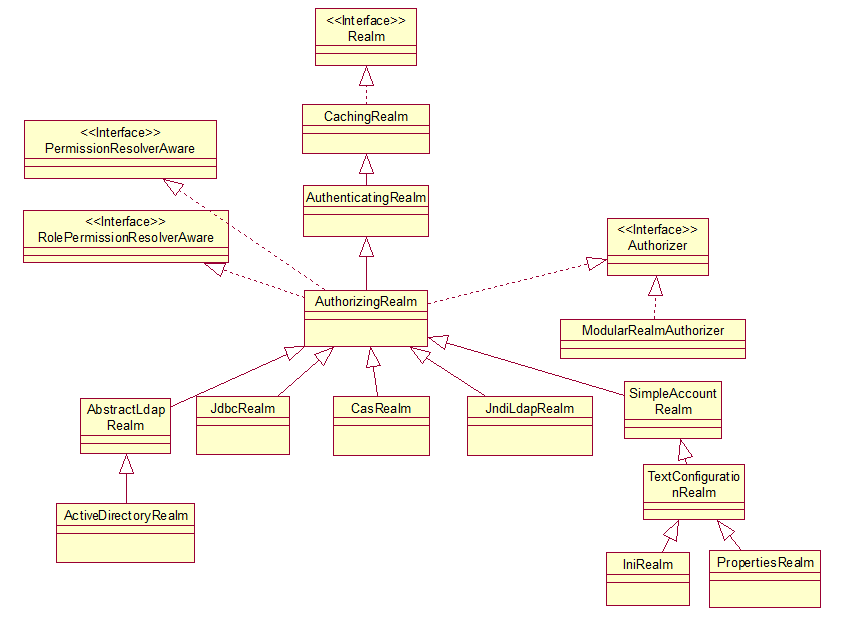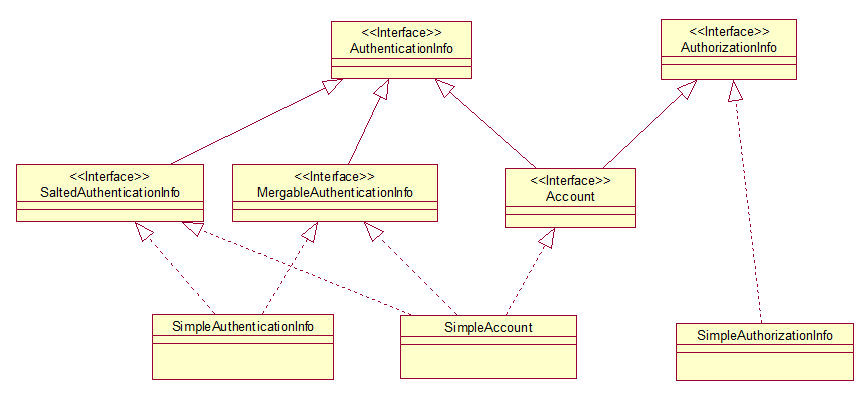shiro源码分析(四)具体的Realm
2019独角兽企业重金招聘Python工程师标准>>> 
首先还是Realm的接口设计图:

这里只来说明SimpleAccountRealm和JdbcRealm的实现。
首先是SimpleAccountRealm不用关心数据的具体来源,只提供了与上层的交互,即实现了AuthenticatingRealm遗留的AuthenticationInfo doGetAuthenticationInfo和AuthorizingRealm遗留的AuthorizationInfo doGetAuthorizationInfo。
如下:
protected final Map<String, SimpleAccount> users; //username-to-SimpleAccountprotected final Map<String, SimpleRole> roles; //roleName-to-SimpleRoleprotected final ReadWriteLock USERS_LOCK;protected final ReadWriteLock ROLES_LOCK;public SimpleAccountRealm() {this.users = new LinkedHashMap<String, SimpleAccount>();this.roles = new LinkedHashMap<String, SimpleRole>();USERS_LOCK = new ReentrantReadWriteLock();ROLES_LOCK = new ReentrantReadWriteLock();//SimpleAccountRealms are memory-only realms - no need for an additional cache mechanism since we're//already as memory-efficient as we can be:setCachingEnabled(false);}SimpleAccountRealm内部有四个属性,Map<String, SimpleAccount> users:用于存放用户账号信息,Map<String, SimpleRole> roles用于存放角色名的信息。这两个都是各种配置的最终归属存储地。
ReadWriteLock USERS_LOCK:由于这些配置信息,一般不会去修改,大部分时间用于查询,所以要使用读写锁。一般的synchronized同步,不管你是读还是写,都要进行等待。写与写需要进行同步,写与读也要进行同步,但读与读却并不需要进行同步,所以对于那些经常读的场景,要使用读写锁ReadWriteLock 来提升性能。ReadWriteLock ROLES_LOCK同理。
有了以上数据源,实现父类的遗留的方法就比较简单了。如下:
protected AuthenticationInfo doGetAuthenticationInfo(AuthenticationToken token) throws AuthenticationException {UsernamePasswordToken upToken = (UsernamePasswordToken) token;SimpleAccount account = getUser(upToken.getUsername());if (account != null) {if (account.isLocked()) {throw new LockedAccountException("Account [" + account + "] is locked.");}if (account.isCredentialsExpired()) {String msg = "The credentials for account [" + account + "] are expired";throw new ExpiredCredentialsException(msg);}}return account;}protected AuthorizationInfo doGetAuthorizationInfo(PrincipalCollection principals) {String username = getUsername(principals);USERS_LOCK.readLock().lock();try {return this.users.get(username);} finally {USERS_LOCK.readLock().unlock();}}代码就很简单了,就是从users中取出相应的用户数据。接下来要分析清几个概念:
AuthorizationInfo、AuthenticationInfo、SimpleAccount、SimpleRole、PrincipalCollection。
PrincipalCollection:看下文档介绍
/**
* A collection of all principals associated with a corresponding { @link Subject Subject}. A <em>principal</em> is
* just a security term for an identifying attribute, such as a username or user id or social security number or
* anything else that can be considered an 'identifying' attribute for a { @code Subject}.
* <p/>
* A PrincipalCollection organizes its internal principals based on the { @code Realm} where they came from when the
* Subject was first created. To obtain the principal(s) for a specific Realm, see the { @link #fromRealm} method. You
* can also see which realms contributed to this collection via the { @link #getRealmNames() getRealmNames()} method.
*/
一个principal仅仅是Subject的一个标识而已,如可以是用户名,用户id等。PrincipalCollection则是这些属性的集合。每个用户属性可以来自不同的Realm。Collection fromRealm(String realmName)可以获取某个Realm的所有用户属性。Set<String> getRealmNames()可以获取到与Subject关联的用户的属性来自于哪些Realm。
Object getPrimaryPrincipal():主要是用于获取唯一标示,如UUID、username等。
接口如下:

MutablePrincipalCollection如下:
public interface MutablePrincipalCollection extends PrincipalCollection {void add(Object principal, String realmName);void addAll(Collection principals, String realmName);void addAll(PrincipalCollection principals);void clear();
}我们知道每一个标示都有所属的realm,所以再添加的时候,要带上realmName。
SimplePrincipalCollection:
private Map<String, Set> realmPrincipals;一个重要的数据集合,key是realm的name,value是principal集合。
这个接口分支一直在强调,每个principal都是有所属的realm的。
PrincipalMap:我这一块没有搞明白,先放下。
AuthenticationInfo 它是含有用户和密码信息的地方:
public interface AuthenticationInfo extends Serializable {PrincipalCollection getPrincipals();Object getCredentials();
}AuthorizationInfo :存放用户权限的地方
public interface AuthorizationInfo extends Serializable {Collection<String> getRoles();Collection<String> getStringPermissions();Collection<Permission> getObjectPermissions();
}类图如下:

MergableAuthenticationInfo 意味着AuthenticationInfo可以进行合并:
public interface MergableAuthenticationInfo extends AuthenticationInfo {void merge(AuthenticationInfo info);
}SaltedAuthenticationInfo 主要用于密码匹配,后续文章专门说明:
public interface SaltedAuthenticationInfo extends AuthenticationInfo {ByteSource getCredentialsSalt();
}SimpleAuthenticationInfo:存储了三个重要的属性:
protected PrincipalCollection principals;protected Object credentials;protected ByteSource credentialsSalt;然后就是实现了MergableAuthenticationInfo 接口,可以进行合并,这里的合并在第一篇文章中Realm认证中提到过:
public void merge(AuthenticationInfo info) {if (info == null || info.getPrincipals() == null || info.getPrincipals().isEmpty()) {return;}if (this.principals == null) {this.principals = info.getPrincipals();} else {if (!(this.principals instanceof MutablePrincipalCollection)) {this.principals = new SimplePrincipalCollection(this.principals);}((MutablePrincipalCollection) this.principals).addAll(info.getPrincipals());}//only mess with a salt value if we don't have one yet. It doesn't make sense//to merge salt values from different realms because a salt is used only within//the realm's credential matching process. But if the current instance's salt//is null, then it can't hurt to pull in a non-null value if one exists.////since 1.1:if (this.credentialsSalt == null && info instanceof SaltedAuthenticationInfo) {this.credentialsSalt = ((SaltedAuthenticationInfo) info).getCredentialsSalt();}Object thisCredentials = getCredentials();Object otherCredentials = info.getCredentials();if (otherCredentials == null) {return;}if (thisCredentials == null) {this.credentials = otherCredentials;return;}if (!(thisCredentials instanceof Collection)) {Set newSet = new HashSet();newSet.add(thisCredentials);setCredentials(newSet);}// At this point, the credentials should be a collectionCollection credentialCollection = (Collection) getCredentials();if (otherCredentials instanceof Collection) {credentialCollection.addAll((Collection) otherCredentials);} else {credentialCollection.add(otherCredentials);}}主要分principals、credentialsSalt 和credentials三项的合并,代码也和简单。
SimpleAuthorizationInfo:存放了认证用户的角色和用户权限。
protected Set<String> roles;
protected Set<String> stringPermissions;
protected Set<Permission> objectPermissions;最重要的就是SimpleAccount:
public class SimpleAccount implements Account, MergableAuthenticationInfo, SaltedAuthenticationInfo, Serializable {private SimpleAuthenticationInfo authcInfo;private SimpleAuthorizationInfo authzInfo;private boolean locked;private boolean credentialsExpired;
}它有SimpleAuthenticationInfo 、SimpleAuthorizationInfo ,所以是用户认证信息和权限信息的汇总。
还有两个属性locked和credentialsExpired,用来表示用户的锁定和密码过期的状态。
至此整个SimpleAccount便介绍完了。
回到SimpleAccountRealm,SimpleAccountRealm已经拥有Map<String, SimpleAccount> users和Map<String, SimpleRole> roles数据了,但是这些数据是怎么产生的呢?这就需要交给它的子类TextConfigurationRealm来完成:
private volatile String userDefinitions;
private volatile String roleDefinitions;仅仅两个字符串包含了所有的用户和角色的配置总来源。所以TextConfigurationRealm主要就是对这两个字符串的解析:
@Override
protected void onInit() {super.onInit();processDefinitions();}
protected void processDefinitions() {try {//解析角色配置processRoleDefinitions();//解析用户配置processUserDefinitions();} catch (ParseException e) {String msg = "Unable to parse user and/or role definitions.";throw new ConfigurationException(msg, e);}}
protected void processRoleDefinitions() throws ParseException {String roleDefinitions = getRoleDefinitions();if (roleDefinitions == null) {return;}//先将角色字符串按行分割,然后每行再按照key value分割Map<String, String> roleDefs = toMap(toLines(roleDefinitions));processRoleDefinitions(roleDefs);}
protected void processRoleDefinitions(Map<String, String> roleDefs) {if (roleDefs == null || roleDefs.isEmpty()) {return;}for (String rolename : roleDefs.keySet()) {String value = roleDefs.get(rolename);SimpleRole role = getRole(rolename);if (role == null) {role = new SimpleRole(rolename);add(role);}Set<Permission> permissions = PermissionUtils.resolveDelimitedPermissions(value, getPermissionResolver());role.setPermissions(permissions);}}再通过PermissionResolver将字符串形式的权限转化成Permission对象,知道大致情况了,就可以了,不需要每一步都弄清楚。
TextConfigurationRealm主要用于解析两个配置字符串,这两个配置字符串的产生则继续交给子类来完成。IniRealm则是通过ini配置文件来产生这两个字符串,PropertiesRealm则是通过properties文件来产生这两个字符串。
至此,SimpleAccountRealm这一路就大致走通了,接下来就是另一条路JdbcRealm了。
public class JdbcRealm extends AuthorizingRealm {protected static final String DEFAULT_AUTHENTICATION_QUERY = "select password from users where username = ?";protected static final String DEFAULT_SALTED_AUTHENTICATION_QUERY = "select password, password_salt from users where username = ?";protected static final String DEFAULT_USER_ROLES_QUERY = "select role_name from user_roles where username = ?";protected static final String DEFAULT_PERMISSIONS_QUERY = "select permission from roles_permissions where role_name = ?";protected DataSource dataSource;
}首先是含有这几个默认的sql和DataSource dataSource,用于从数据库中获取相应的用户、角色、权限等数据。
根据上一篇文章我们知道JdbcRealm 要实现AuthenticatingRealm遗留的AuthenticationInfo doGetAuthenticationInfo和AuthorizingRealm遗留的AuthorizationInfo doGetAuthorizationInfo。下面就看看是怎么来实现的:
protected AuthenticationInfo doGetAuthenticationInfo(AuthenticationToken token) throws AuthenticationException {UsernamePasswordToken upToken = (UsernamePasswordToken) token;String username = upToken.getUsername();// Null username is invalidif (username == null) {throw new AccountException("Null usernames are not allowed by this realm.");}Connection conn = null;SimpleAuthenticationInfo info = null;try {conn = dataSource.getConnection();String password = null;String salt = null;switch (saltStyle) {case NO_SALT://根据用户名去查找密码password = getPasswordForUser(conn, username)[0];break;case CRYPT:// TODO: separate password and hash from getPasswordForUser[0]throw new ConfigurationException("Not implemented yet");//break;case COLUMN:String[] queryResults = getPasswordForUser(conn, username);password = queryResults[0];salt = queryResults[1];break;case EXTERNAL:password = getPasswordForUser(conn, username)[0];//此时salt不存在数据库中,默认的值为usernamesalt = getSaltForUser(username);}if (password == null) {throw new UnknownAccountException("No account found for user [" + username + "]");}//根据用户名、密码、盐值构建一个SimpleAuthenticationInfoinfo = new SimpleAuthenticationInfo(username, password.toCharArray(), getName());if (salt != null) {info.setCredentialsSalt(ByteSource.Util.bytes(salt));}} catch (SQLException e) {final String message = "There was a SQL error while authenticating user [" + username + "]";if (log.isErrorEnabled()) {log.error(message, e);}// Rethrow any SQL errors as an authentication exceptionthrow new AuthenticationException(message, e);} finally {JdbcUtils.closeConnection(conn);}return info;}
private String[] getPasswordForUser(Connection conn, String username) throws SQLException {String[] result;boolean returningSeparatedSalt = false;switch (saltStyle) {case NO_SALT:case CRYPT:case EXTERNAL:result = new String[1];break;default:result = new String[2];returningSeparatedSalt = true;}PreparedStatement ps = null;ResultSet rs = null;try {ps = conn.prepareStatement(authenticationQuery);ps.setString(1, username);// Execute queryrs = ps.executeQuery();// Loop over results - although we are only expecting one result, since usernames should be uniqueboolean foundResult = false;while (rs.next()) {// Check to ensure only one row is processedif (foundResult) {throw new AuthenticationException("More than one user row found for user [" + username + "]. Usernames must be unique.");}result[0] = rs.getString(1);if (returningSeparatedSalt) {result[1] = rs.getString(2);}foundResult = true;}} finally {JdbcUtils.closeResultSet(rs);JdbcUtils.closeStatement(ps);}return result;}
protected String getSaltForUser(String username) {return username;}代码很简单就不再一一细说。再看下doGetAuthorizationInfo是怎么实现的:
protected AuthorizationInfo doGetAuthorizationInfo(PrincipalCollection principals) {//null usernames are invalidif (principals == null) {throw new AuthorizationException("PrincipalCollection method argument cannot be null.");}String username = (String) getAvailablePrincipal(principals);Connection conn = null;Set<String> roleNames = null;Set<String> permissions = null;try {conn = dataSource.getConnection();// Retrieve roles and permissions from databaseroleNames = getRoleNamesForUser(conn, username);if (permissionsLookupEnabled) {permissions = getPermissions(conn, username, roleNames);}} catch (SQLException e) {final String message = "There was a SQL error while authorizing user [" + username + "]";if (log.isErrorEnabled()) {log.error(message, e);}// Rethrow any SQL errors as an authorization exceptionthrow new AuthorizationException(message, e);} finally {JdbcUtils.closeConnection(conn);}SimpleAuthorizationInfo info = new SimpleAuthorizationInfo(roleNames);info.setStringPermissions(permissions);return info;}第一步先根据PrincipalCollection 来获取用户名,第二步根据用户名来获取角色,第三部根据角色和用户名来获取权限。后两步都是执行简单的sql,不再说,看下如何由PrincipalCollection 获取用户名,该方法定义在CachingRealm中:
protected Object getAvailablePrincipal(PrincipalCollection principals) {Object primary = null;if (!CollectionUtils.isEmpty(principals)) {Collection thisPrincipals = principals.fromRealm(getName());if (!CollectionUtils.isEmpty(thisPrincipals)) {primary = thisPrincipals.iterator().next();} else {//no principals attributed to this particular realm. Fall back to the 'master' primary:primary = principals.getPrimaryPrincipal();}}return primary;}两种情况,首先是获取当前Realm的Principals,如果有取其第一个。如果没有,则调用getPrimaryPrincipal()方法。然后看下JdbcRealm的一个简单使用:
如果默认按照JdbcRealm的sql来作为数据库的查询来说,建表如下:
users表:
CREATE TABLE `users` (`id` int(11) NOT NULL AUTO_INCREMENT,`username` varchar(45) NOT NULL,`password` varchar(45) NOT NULL,`password_salt` varchar(45) DEFAULT NULL,PRIMARY KEY (`id`),UNIQUE KEY `username_UNIQUE` (`username`)
) ENGINE=InnoDB AUTO_INCREMENT=4 DEFAULT CHARSET=utf8;user_roles表:
CREATE TABLE `user_roles` (`id` int(11) NOT NULL AUTO_INCREMENT,`username` varchar(45) DEFAULT NULL,`role_name` varchar(45) DEFAULT NULL,PRIMARY KEY (`id`)
) ENGINE=InnoDB AUTO_INCREMENT=7 DEFAULT CHARSET=utf8;roles_permissions表:
CREATE TABLE `roles_permissions` (`id` int(11) NOT NULL AUTO_INCREMENT,`role_name` varchar(45) DEFAULT NULL,`permission` varchar(45) DEFAULT NULL,PRIMARY KEY (`id`)
) ENGINE=InnoDB DEFAULT CHARSET=utf8;文章最后会给出数据库sql文件。
然后就是配置ini文件:
[main]
#realm
dataSource=com.mchange.v2.c3p0.ComboPooledDataSource
dataSource.driverClass=com.mysql.jdbc.Driver
dataSource.jdbcUrl=jdbc:mysql://localhost:3306/shiro
dataSource.user=root
dataSource.password=XXXXXX
jdbcRealm=org.apache.shiro.realm.jdbc.JdbcRealm
jdbcRealm.dataSource=$dataSource
jdbcRealm.permissionsLookupEnabled=true
securityManager.realms=$jdbcRealm使用的dataSource是c3p0的dataSource,mysql驱动也是必然不能少的,所以maven中要加入依赖:
<!-- mysql驱动 --> <dependency> <groupId>mysql</groupId> <artifactId>mysql-connector-java</artifactId> <version>5.1.29</version> </dependency> <!-- 连接池 --> <dependency> <groupId>c3p0</groupId> <artifactId>c3p0</artifactId> <version>0.9.1.2</version> </dependency>为了输出方便代码更改为:
public class ShiroTest {@Test public void testHelloworld() { init();Subject subject=login("lg","123");System.out.println(subject.hasRole("role1"));System.out.println(subject.hasRole("role2"));System.out.println(subject.hasRole("role3"));}private Subject login(String userName,String password){//3、得到Subject及创建用户名/密码身份验证Token(即用户身份/凭证) Subject subject = SecurityUtils.getSubject(); UsernamePasswordToken token = new UsernamePasswordToken(userName,password); subject.login(token);return subject;}private void init(){//1、获取SecurityManager工厂,此处使用Ini配置文件初始化SecurityManager Factory<org.apache.shiro.mgt.SecurityManager> factory = new IniSecurityManagerFactory("classpath:shiro.ini"); //2、得到SecurityManager实例 并绑定给SecurityUtils org.apache.shiro.mgt.SecurityManager securityManager = factory.getInstance(); SecurityUtils.setSecurityManager(securityManager); }
}对于lg用户,在数据库中它是有两个角色的,role1和role2。所以结果为true、true、false。
true
true
falseOK,通过。最后附上JdbcRealm的使用例子。
作者:乒乓狂魔
转载于:https://my.oschina.net/pingpangkuangmo/blog/376299
shiro源码分析(四)具体的Realm相关推荐
- gSOAP 源码分析(四)
gSOAP 源码分析(四) 2012-6-2 邵盛松 前言 本文主要说明gSOAP中对Client的认证分析 gSOAP中包含了HTTP基本认证,NTLM认证等,还可以自定义SOAP Heard实现认 ...
- ABP源码分析四十七:ABP中的异常处理
ABP源码分析四十七:ABP中的异常处理 参考文章: (1)ABP源码分析四十七:ABP中的异常处理 (2)https://www.cnblogs.com/1zhk/p/5538983.html (3 ...
- 【投屏】Scrcpy源码分析四(最终章 - Server篇)
Scrcpy源码分析系列 [投屏]Scrcpy源码分析一(编译篇) [投屏]Scrcpy源码分析二(Client篇-连接阶段) [投屏]Scrcpy源码分析三(Client篇-投屏阶段) [投屏]Sc ...
- Spring 源码分析(四) ——MVC(二)概述
随时随地技术实战干货,获取项目源码.学习资料,请关注源代码社区公众号(ydmsq666) from:Spring 源码分析(四) --MVC(二)概述 - 水门-kay的个人页面 - OSCHINA ...
- 【转】ABP源码分析四十七:ABP中的异常处理
ABP 中异常处理的思路是很清晰的.一共五种类型的异常类. AbpInitializationException用于封装ABP初始化过程中出现的异常,只要抛出AbpInitializationExce ...
- 【转】ABP源码分析四:Configuration
核心模块的配置 Configuration是ABP中设计比较巧妙的地方.其通过AbpStartupConfiguration,Castle的依赖注入,Dictionary对象和扩展方法很巧妙的实现了配 ...
- 谷歌chrome浏览器的源码分析(四)
上一次说到需要调用这个OpenURLFromTab函数,那么这个函数是做什么的呢?从名称上可能猜到它是打开网页,但是是从目前TAB页里打开呢?还是新建一个?或者使用每个TAB页一个进程呢?这些疑惑,只 ...
- 【转】ABP源码分析四十六:ABP ZERO中的Ldap模块
通过AD作为用户认证的数据源.整个管理用户认证逻辑就在LdapAuthenticationSource类中实现. LdapSettingProvider:定义LDAP的setting和提供Defaut ...
- 【转】ABP源码分析四十五:ABP ZERO中的EntityFramework模块
AbpZeroDbContext:配置ABP.Zero中定义的entity的Dbset EntityFrameworkModelBuilderExtensions:给PrimitiveProperty ...
- 【转】ABP源码分析四十三:ZERO的本地化
ABP Zero模块扩展了ABP基础框架中的本地化功能,实现了通过数据库对本地化功能进行管理.其通过数据库保存本地化语言及其资源. ApplicationLanguage:代表本地化语言的实体类.一种 ...
最新文章
- “编程能力差,90%是输在这点上!”谷歌AI开发专家:逆袭并没那么难!
- 使用contour自定义等高线值
- wsl ubuntu update显示err: 404 Not Found解决方法
- 武大计算机学院推免清北,南大2020年推免生来自哪儿?山大73,武大41,清北5人...
- python ctime函数_Python中的ctime()方法使用教程
- 分布式锁用Redis还是Zookeeper?
- vue组件的生命周期和执行过程
- zookeeper和etcd有状态服务部署
- Kafka JMX监控报错 Failed to get broker metrics for BrokerIdentity(128,192.168.2.128,9999,true,false,Map
- 何小鹏谈“小米造车”:我们要为勇敢者鼓掌
- MapReduce中一次reduce方法的调用中key的值不断变化分析及源码解析
- 清华大学数据结构c语言版pdf,清华大学出版社-图书详情-《数据结构(C语言版)(第3版)》...
- 应用多元统计分析高惠璇pdf_EViews统计分析与应用pdf txt mobi下载及读书笔记
- 单机类似节奏大师游戏源码
- android输入法ios下载安装,仿ios输入法
- 浏览器禁用第三方Cookie
- Window部分软件图标显示不正常
- win7休眠设置在哪里_win7系统如何关闭休眠模式--win7w.com
- SQL SERVER(32)Transact-SQL概述
- mac os壁纸软件_如何在Mac OS X上更改桌面墙纸
热门文章
- 【数据安全案例】北京破获贩卖个人信息案 涉及上千万条公民信息
- “钱”在这个社会是怎么一个地位
- PowerPC VxWorks BSP分析7——image压缩
- 电梯为什么显示停止服务器,教你奥的斯服务器怎么看故障
- python urlretrieve登录下载_使用python urlretrieve下载文件
- 笔记本计算机硬件知识,知识和经验:笔记本计算机的基本知识_计算机硬件和网络_IT /计算机_信息...
- 了解下RDF 主要元素
- 在 CentOS 8 中删除旧的 Linux 内核
- 嵌入式为什么不受欢迎?谈谈我对嵌入式的理解!
- 甘肃省计算机二级考试题库,2011甘肃省计算机等级考试二级最新考试试题库(完整版)...
